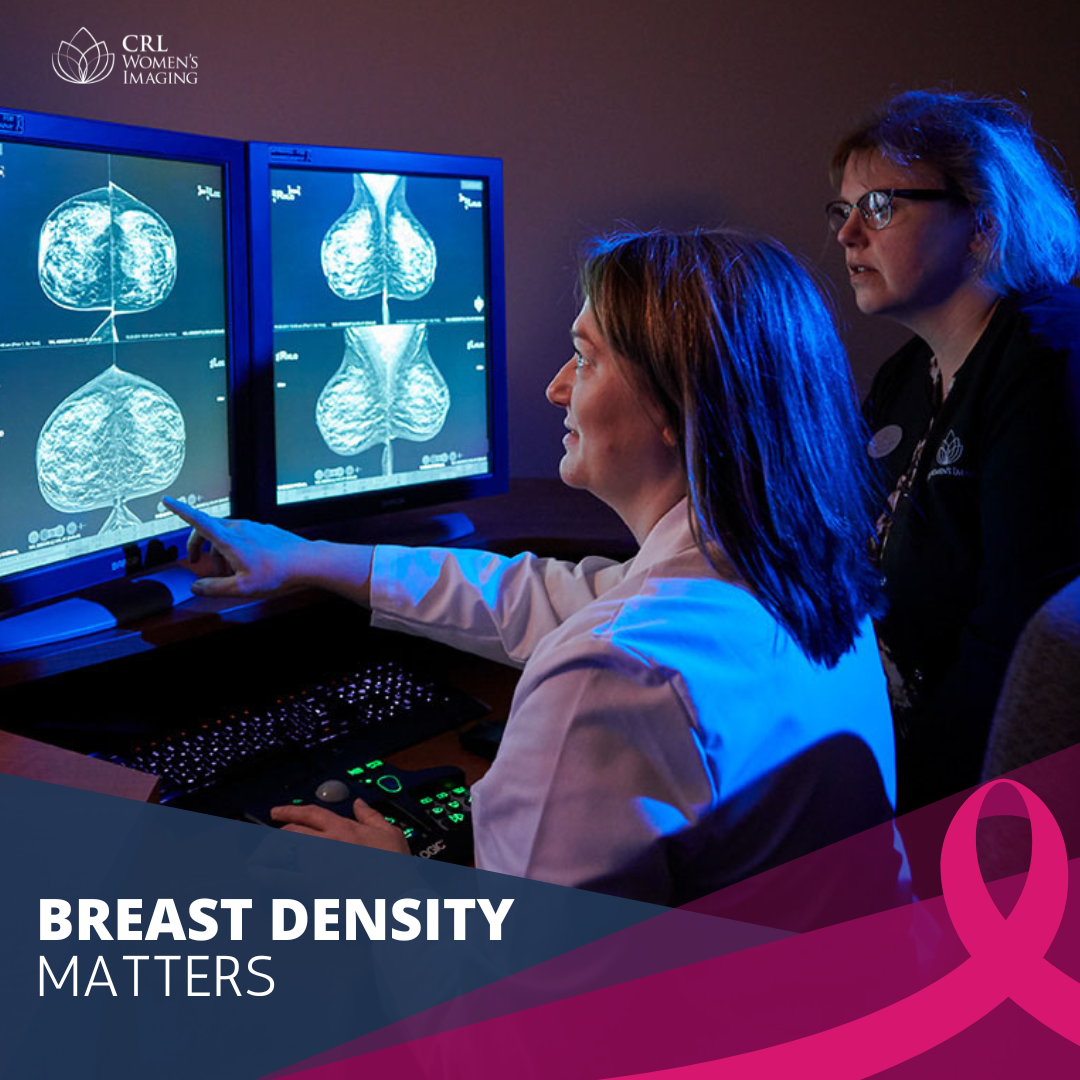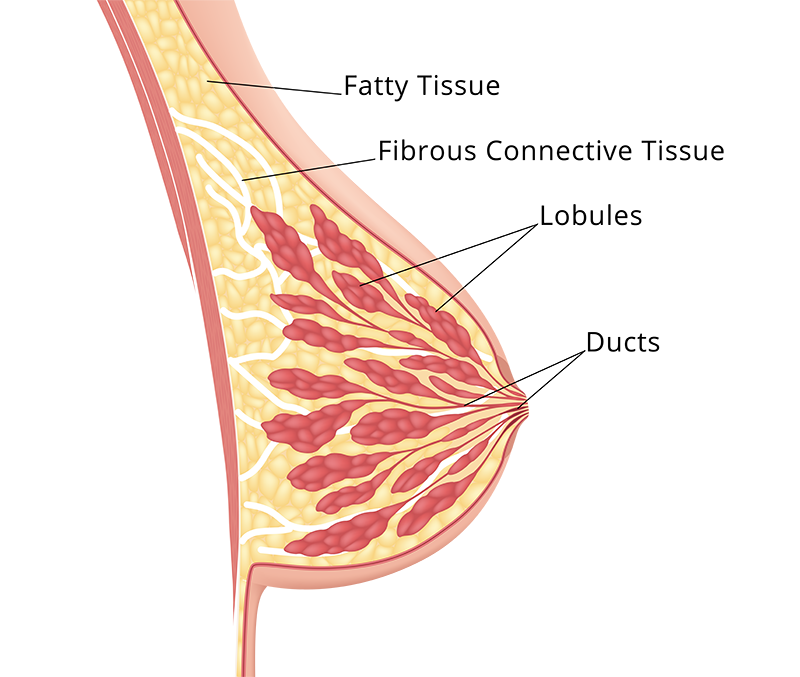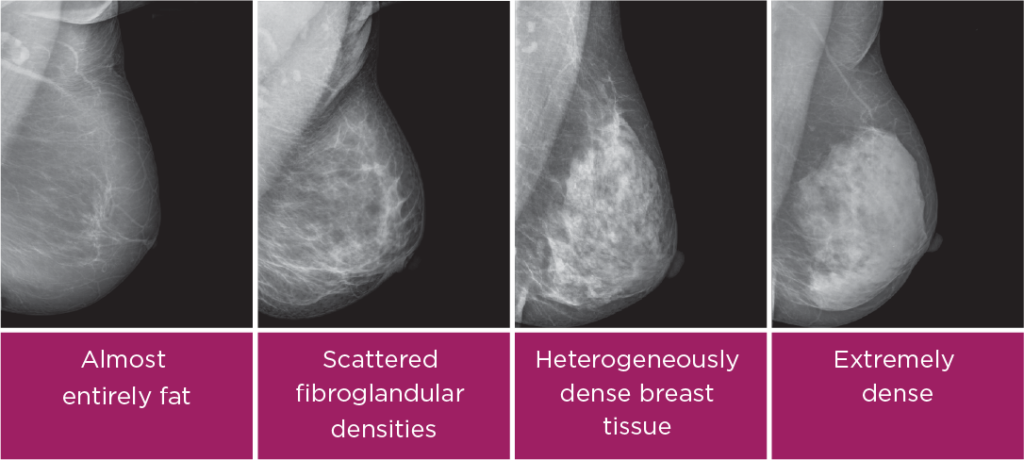
Breast Density: Understanding its Significance and Impact on Breast Health
Breast health is a crucial aspect of overall well-being for women worldwide, and annual screening mammograms play a pivotal role in the early detection and treatment of breast cancer. A significant factor gaining attention recently is breast density, its implications for women’s health, and its impacts on breast cancer detection and risk assessment.
There are two main reasons breast density is important:
- An increased risk of breast cancer. While the reason is still unknown, women with dense breast tissue have a higher chance of breast cancer when compared to women who have less dense breast tissue.
- Dense breast tissue makes it more difficult for radiologists to detect cancer because dense (fibrous and glandular) breast tissue appears white on a mammogram, potentially obscuring cancer which also appears white.
What Is Breast Density
Dense breasts are common and seen in nearly half of all women and can only be determined by a mammogram, not based on size, firmness, how they feel, or touch. Breast density refers to the amount of fibrous and glandular tissue in a woman’s breasts in comparison to the amount of fatty tissue shown on a mammogram.
Breasts are composed of different types of tissue
• Glandular tissue that includes the breast lobules and ducts
• Fibrous tissue, which is sometimes referred to as supportive or connective tissue
• Fatty tissue fills the gaps between the glandular and fibrous tissue and is largely responsible for determining breast size

How Is Breast Density Determined
By using low-dose X-rays, mammograms image the tissue within the breast. These scans differentiate between fatty tissue, which appears dark and transparent, and dense tissue, which appears white. The radiologist analyzes the ratio of fatty tissue to dense tissue to determine the density level according to the classification system for mammography provided by the American College of Radiology Breast Imaging Reporting & Data System.
Breast Density is classified into four categories:

- Almost entirely fat, signifying that the breasts are almost entirely composed of fat. This is the outcome for around one out of every ten women.
- Scattered fibroglandular densities where most of the breast tissue appears nondense, but there are some scattered areas of density. This is the outcome for almost four out of every ten women.
- Heterogeneously dense, meaning that the majority of the breast tissue is dense but showing some areas of nondense tissue. This is the outcome for almost four out of every ten women.
- Extremely dense means that almost all of the breast tissue is dense. This is the outcome for around one out of every ten women.
What Causes Breast Density
The reason for dense breast tissue is undetermined; however, some factors that may influence breast density include:
- Age. Although some women have dense breasts at any age, density may diminish with age.
- Body Mass Index (BMI).When compared to obese women, women with a lower BMI are more likely to have dense breast tissue.
- Combination Hormone Therapy.Women who undergo Estrogen Progesterone/Progestin Hormone Therapy (EPT) to treat menopausal symptoms are more likely to have dense breast tissue.
Mammograms Are Essential
Mammograms are the only test proven to reduce breast cancer mortality and will detect most breast cancers, including those in women with dense breasts. It is important for women to have annual screening mammograms beginning at the age of 40.
Digital Breast Tomosynthesis, the most recent advancement in mammography technology, often called 3D Mammography, produces a three-dimensional image of the breast with remarkable clarity and detail by imaging the breast in numerous ‘layers.’ When each layer is examined independently, potential cancer is less likely to be obscured by overlaying breast tissue resulting in fewer biopsies and additional tests and an increase in cancer detection.
Breast Density Notification
Breast density is noted on your mammography report, and a result letter will inform you if your breasts are dense. While the FDA recently passed regulations regarding patient notification of dense breasts, this has been a requirement in Minnesota since 2014, where heterogeneously dense or extremely dense breasts are noted on the written report sent to all women by their mammography facility.
Breast Health Assessment
Breast density information enables healthcare providers to assess the risk of breast cancer and provide a more comprehensive evaluation when combined with other risk factors, such as family history and genetic predisposition allowing for personalized screening recommendations and preventive strategies.
Awareness Fosters Empowerment
Breast density is a vital component of breast health with significant cancer detection and risk assessment implications. Understanding the importance of breast density empowers women to take an active role in their breast health journey, allowing for early detection and individualized care. When it comes to breast health, staying informed and being proactive can make a world of difference.
To Schedule Your Mammogram
Phone: 952-915-4320
About CRL Women’s Imaging
CRL Women’s Imaging is a leader in outpatient imaging and designated as Breast Center of Excellence by the American College of Radiology (ACR). Our team of dedicated, board-certified breast imagers with broad expertise and a genuine interest in breast imaging and our knowledgeable technologists certified in mammography and ultrasound are committed to provide our patients with the high-quality compassionate care they can trust.
“Early detection of breast cancer saves lives. And with the tools of 3D mammography/tomosynthesis and supplemental screening breast ultrasound we are better equipped than ever to positively impact women’s health.” – Jillian Karow, MD, Medical Director, CRL Women’s Imaging